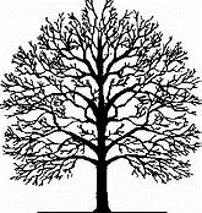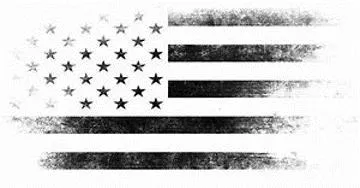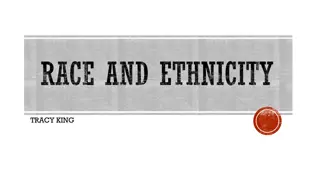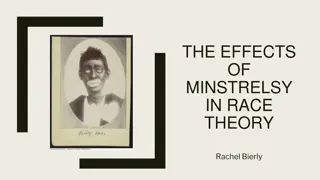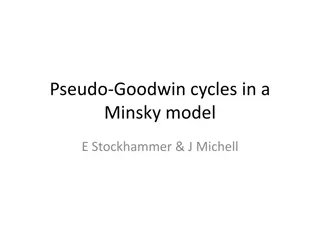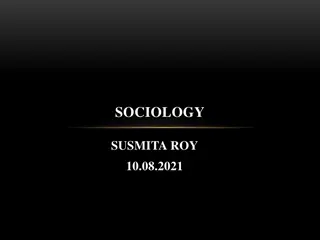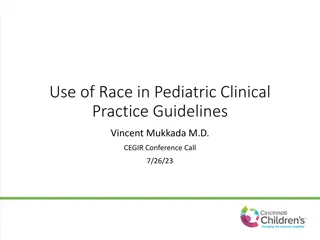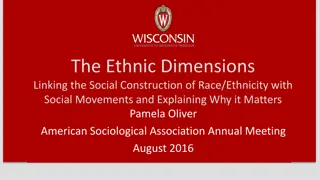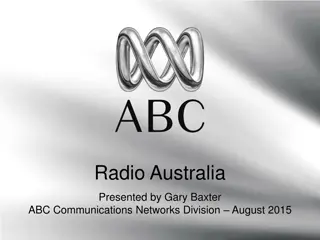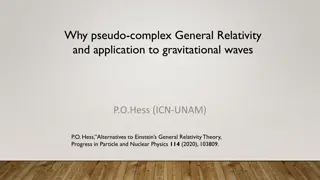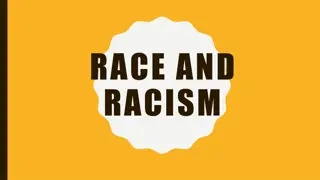Pseudo-Scientific Ideas About Race and Eugenics in the USA and Australia
The eugenics movement in the USA, under leaders like Charles Davenport, promoted the separation of "inferior" races to prevent genetic contamination of the "superior" groups. Laws like the Virginia Racial Integrity Act enforced racial segregation and punished interracial marriages. This era saw the rise of pseudo-scientific racism and eugenics, influencing policies and attitudes towards race in the USA and Australia.
Download Presentation

Please find below an Image/Link to download the presentation.
The content on the website is provided AS IS for your information and personal use only. It may not be sold, licensed, or shared on other websites without obtaining consent from the author. Download presentation by click this link. If you encounter any issues during the download, it is possible that the publisher has removed the file from their server.
E N D
Presentation Transcript
Grade 11 History Pseudo Scientific ideas about race Part 2 Practices of race and eugenics in the USA, Australia
Race and eugenics in the USA: The eugenics movement gained a wide following and became extremely popular in the Unites States under the leadership of Charles Davenport, a biologist. Davenport and other scientists of the time believed that intelligence and other human characteristics were inherited or, in other words, that they were passed down from parents to their children in their genes. Davenport was particularly concerned that what he saw as feebleminded and inferior people would interfere and reduce the intelligence and productivity of the superior groups in America if they were allowed to reproduce with them. Eugenicists like Davenport therefore supported the removal and separation of the weak and inferior people from the rest of society so that their genetic material would not contaminate the superior groups. This inferior groups also included people of colour such as African Americans and American Indians.
Activity 4: Source B : Punishment for marriages if any white person intermarry with a coloured person, or any coloured person intermarry with a white person, he shall be guilty of a felony(crime) and shall be punished (by being imprisoned) for not less than one no more than five years. Note that at that time African Americans were referred to as coloured. - Extract from the Virginia Racial Integrity Act. SOURCE B : SOURCE A : Source C : White race purity is the cornerstone of our civilisation. Mixing with non-white blood, particularly with Negro blood, would spell the downfall of our civilisation. This is a matter of both national and racial life and death, and no effort would be spared to guard against the greatest of all dangers the danger of race mixing. Source A: Anti miscegenation ( racial mixing) laws were passed in the American states of Virginia. These laws prevented people of different racial groups from having a sexual relationship or marrying. By 1928,eugenics was part of the curriculum in most American high schools as well as universities like Harvard and Columbia. This clearly influenced the thinking of large numbers of educated people in the United States. As a result, many American States began to pass eugenics laws in one form or another. SOURCE C : Note at this time African Americans were referred to as Negroes. - Lothrop Stoddard, a lawyer and self proclaimed eugenicist, justified this law in Virginia.
Activity 4: Study Sources A to C and then answer the questions below. 1. According to the protesters opinion what are the weaknesses from which the inferior race is thought to suffer. 2. Are these demonstrators supporters of positive or negative eugenics? Give a reason for your answer. 3. What did the Virginia Racial Integrity Act rule with regards to interracial marriages? 4. Why do you think this law was called the Racial Integrity Act? Explain your answer. 5. Why did Lothrop Stoddard believe that there should be a law against racial mixing?
Elements of pseudo-scientific racism, Social Darwinism and Eugenics are evident in American history: The first white settlers in the United States of America were of European origin, the majority of who were Anglo Saxon Protestants. They forced the majority of the Native Americans off their land, killed many of them, and placed the rest in reserves. Later, in the 18th century, African people were taken to the USA, and sold as slaves to farmers situated mainly in the southern states. Here they were forced to work on the sugar and tobacco plantations as slaves. Misguided racial beliefs continued to influence racial attitudes in the USA and led to racial intolerance in the 19th and 20th centuries, From 1904 until shortly after the close of the Second World War, the United States aggressively engaged in a scientific quest to create a master race. American eugenics forced on the ideas that some races were genetically superior to others. The Supreme Court of the USA eventually came to sanction eugenic practises, and 27 US states enacted incredibly racial laws enforcing its doctrines. Overseeing these laws were a group of scientists and doctors who aimed to eradicate anyone seen as a threat to society. These included immigration from Europe, Native Americans, epileptics, alcoholics, Jews, Mexicans, Blacks, criminals, the mentally ill, and even unemployed and homeless people. The findings of these genetic experts were used to limit immigration of the supposedly inferior races e.g. those from Eastern and Southern Europe and Ireland. White supremacists also used leading American Eugenicist was able to attract the necessary funding for his laboratory at Cold Harbour from the Carnegie Institute and the Rockefeller Foundation. The work he did there led to many American states passing laws that led to the sterilisation of so called defectives .
The Ku Klux Klan (KKK) was formed by white extremists in Tennessee after the American Civil War. This secret organisation aimed to: Defend white supremacy and protect whites from blacks and other ethnic minorities. Defend Protestant superiority against Catholics and Jews. Clean up American society by attacking anyone who was considered a threat to the moral standards. Klansmen terrorised black people to prevent them from registering to vote by: Burning crosses near homes of victims Beating up or whipping victims Burning property belonging to blacks. Clan membership was only open to WASPS(White Anglo-Saxon Protestant Americans) and reached its peak of about five million in 1923. It was especially strong in the south and west of the USA. The original KKK ceased to exist at the end of the 19th century but was revived in 1915 by William J Simmons, a preacher influenced by Thomas Dixon s book, The Klux Klan (1905) and the film of the book, Birth of a Nation. The revival of the KKK led to the following; The National Association for the Advancement of Coloured People (NAACP) became the main opponent of the KKK. After the First World War the Ku Klux Klan also became extremely hostile to Jews, Roman Catholics, socialists, communists and anybody they identified as foreigners. In November 1922 Hiram W Evans became the Klan s Imperial Wizard (leader). Under his leadership the organisation grew significantly and in the 1920s Klansmen had reached 4 million. However, after the conviction of the Klan leader, David C Stephenson, for a second-degree murder, and evidence of corruption by other members, membership fell about 30 000. Numbers continued to fall during the Great Depression and the Second World War. The KKK was disbanded in 1944.
Activity 5: Text in cartoon reads as follows: The Union as it was The vision as it was This is a white man s government Worse than slavery. SOURCE B : SOURCE A : Source B: A cartoon entitled The White League and the Ku Klux Klan: Worse than Slavery. Drawn by Thomas Nast, Harper s Weekly 1874, taken from www.lookandlearn.com. Source A: A photograph of a KKK lynching taken in 1930. Taken from Essential Modern World History by S Waugh.
Activity 5: 1. Refer to Source A. a) Who were the victims of the lynching and why would they have been targeted? b) Comment on the reaction of the crowd to the lynching. c) What were the KKK hoping to achieve by public hangings. d) What does this photograph reveal about the KKK s attitude towards race? e) Explain whether photographs such as these are useful pieces of historical evidence for a historian studying racism in the USA. 2. Consult Source B. a) Who or what were the White League and the KKK? b) Is the cartoon in favour of the White League and the KKK? Support your answer by making reference to the cartoon. c) What comments is the cartoonist making about the US government s attitude towards race with the caption: This is a white man s government . d) Do you think this is an accurate reflection of the situation in the USA in 1874. Give a reason for your answer. e) Explain the limitations of cartoons such as the one shown in Source B as pieces of historical evidence. Use Source A and B. as well as your own knowledge to write a paragraph of about 10 lines ( about 110 wards) on the impact organisations such as the KKK had on the lives of African Americans. 3.
Race and eugenics in Australia: The relationship between the British and the Aborigines quickly became hostile. As the British expanded further into Australian territory, there were massacres of Aborigines and it is clear that the Aborigines suffered one of the most serious attempts at extermination ever carried out in history. Britain began to colonise Australia in 1788. The Aborigines, who had always lived there, were gradually driven off their land and away from resources on which they depended.
Australia and the indigenous Australians: Before the arrival of Europeans in Australia, the Aboriginal people had lived in Australia for over 40 000 years. Great cultural diversity existed among Aborigines, with hundreds of languages and dialects in active used by the 19th century. Aborigines led a nomadic lifestyle of hunting and gathering and roamed great distances across Australia. The settlement of Australia by white British colonists began in the early 1800s. Australia was initially used by the British as a penal colony. Convicted prisoners were sent down under . Australia became a penal colony because: Before the American Revolution, Britain sent its convicts there. After there evolutionary war American refused to take any more convicts. This left Britain in need of a place to send them. They wanted a post in the east for military purposes. Most of the criminals sent to Australia were blue-collar (working class) citizens from England and Ireland. These people such as constructing roads, bridges, and buildings. In the early years the penal colony operated like a village. The prisoners: Wore their own clothes. Had their own homes. Could run their own businesses. Free family members were allowed to move to Australia with their inmate relatives and live a normal life. The last convicts to be transported to Australia arrived in Western Australia in 1868.
Other colonies were established by Britain around the continent and European explorers travelled into the interior throughout the 19th century. This resulted in: European diseases and conflict between the British colonists and the indigenous Aborigines. This greatly weakened indigenous Australians throughput this period. Gold rushes and agricultural industries brought prosperity to the British colonies in Australia. Self-governing parliamentary democracies began to be established throughout the six British colonies from the mid-19th century. In 1901 the colonies voted by referendum to unite in a federation and modern Australia came into being. Settlers who arrived in the second half of the century brought with them the Darwinism worldview that had a significant influence on their interactions with Australia s indigenous people. This resulted in: Large numbers of Aborigines being killed in early conflicts with settlers, particularly along Australia s eastern coast. Many others died of diseases that the white settlers had brought with them and against which they had no immunity. As white settlements began to expand and prosper, Aborigines were pushed off ancestral lands and forced to live in the desert like Outback areas. However, as the settlements progressed, the British Government and colonial humanitarians were concerned about the treatment of Aboriginal people. The Victorian Colonial Government decided to allocate reserves of land commonly known as stations, missions or reserves on which Aboriginal people could live. The Wesleyan Missionary Society established the first mission at Buntingdale near Geelong in 1836. The government in the state of Victoria:
Ran some Aboriginal stations, while others were controlled by Anglican or other missionaries. Aimed to control the civilise Aboriginal people, showing clearly how the Social Darwinist worldview of white superiority was evident in colonial Australia. Supported the establishment of thirty-four Aboriginals missions and reserves, while over two hundred existed across Australia. Strictly controlled life on the missions and reserves through an Aborigines Protection Board based in Melbourne. Board members were kept informed of events throughout the colony by correspondents and regional committees. As European settlers took over prime land and the spread of European livestock over vast areas of Australia, the traditional indigenous lifestyle of the Aborigines became less viable. As a result: Some Aborigines were forced to hunt the settlers livestock. The impact of diseases and the settlers industries had a negative impact on the indigenous Australians way of live. With the exception of a few in the remote interior, all surviving indigenous communities gradually became dependent on the settlers population for their livelihood.
During the 1850s, large numbers of white workers in south-eastern Australia, left their employment on sheep or cattle stations (farms) as a result of the Australian gold rush. This led to: Indigenous women, men and children becoming a significant source of labour. Mostly unpaid labour where indigenous workers received rations in the form of food, clothing and other basic necessities.
Practise of race and Eugenics in Australia: HOW DID PSEUDO-SCIENTIFIC RACIAL THEORIES INFLUENCE POLICIES IN AUSTRALIA? Elements of pseudo-scientific racism, Social Darwinism and Eugenics are also evident in Australian history. The Eugenics movement largely existed during the first half of the 2oth century and its origins can be linked to the racial attitudes of many Europeans which prevailed in the late 19th century who had based their racial theories on Social Darwinist ideas. Some historians suggested that the origins of Eugenics in Australia come about as a result of two ideas that were prominent at the time: Racial suicide Racial decay WHY WERE WHITE AUSTRALIANS CONCERNED WITH RACIAL SUICIDE AND WHAT DID THEY ATTEMPT TO DO ABOUT IT? Some white Australians were concerned that their small and slowly growing population was threatened by the rapidly expanding populations of increasingly powerful Asian countries to the north. They assumed that invasion would result unless the European population of the country was quickly increased and the northern parts of the country settled. One of the first laws passed by the Federal Parliament of the newly created Commonwealth population of the country was quickly increased and the northern parts of the country settled.
One of the first laws passed by the Federal Parliament of the newly created Commonwealth of Australia in 1901 was the Immigration Restriction Act, more commonly known as the White Australia Policy. This act limited immigration to those who could pass a dictation test in any European language of the testing officer s choice. This proved to be a major problem for persons of non-European origin, showing how the government s policies discriminated against non-Whites. Between 1920-1921, to boost population size after serious losses suffered by the Australian forces in the First World War, the State Labour Government of New South Wales appointed a Minister of Motherhood, a Mr. JJ McGirr. Adult immigration from the United Kingdom was also encouraged by the British Empire Settlement Act 1922, which sought to populate Australia as well as reduce unemployment and urban overcrowding in the mother country. After the Second World War children were sent to Australia from orphanages and families described as destitute in the UK, sometimes without their permission.
WHY WERE AUSTRALIANS CONCERNED WITH RACIAL DECAY? This second major area of concern for Australian eugenics was racial decay. This was more a global theme adopted by many national eugenic movements. They predicted an inevitable decline in the national stock because of the lesser fertility of the more successful and worthy section of society, the Australians of European decent by comparison with those regarded as being inferior i.e. the Aborigines. The solution to this so-called problem of racial decay was the implementation of an assimilation policy. WHITE IMMIGRATION POLICIES IN AUSTRALIA. The White Australia policy, as already discussed, describes Australia s approach to immigration from the formation of the federation until the latter part of the 20th century, which favoured applicants from certain countries. After the outbreak of war with Japan, the Prime Minister of the time, John Curtin, reinforced the philosophy of the White Australian policy. He said the following: This country shall remain forever the home of the descendants of those people who came here in peace in order to establish in the South Seas an outpost of the British race . During the Second World War, many non-white refugees entered Australia. Most left when the war ended, but many had married Australians and wanted to remain in Australia. Arthur Calwell, the first immigration Minister, attempted to deport them. This resulted in much protest. In 1949, 800 non-European refugees were given permission to stay on in Australia, Japanese war brides among them. This was the first step towards a non-discriminatory immigration policy.
WHY WERE BRITISH CHILDREN SENT TO AUSTRALIA AFTER THE SECOND WORLD WAR? The practise of sending poor orphaned children to British settler colonies began in 1618, with the transportation of 100 vagrant children to the Virginia Colony in America. The purpose was to help alleviate the shortage of labour in the colonies. The sending of these unaccompanied children, who were often abandoned, illegitimate, poverty stricken or delinquent, from the slums of British cities, to the colonies, meant the wide open spaces of the British Empire would be populated. Waves of immigration to various British colonies around the world took place, which were the result of political and economic events of the time. In 1947, shortly after the Second World War, during a time of post was economic depression, nearly 500 child migrants were taken from Britain to Western Australia. This resumed a programme that was started in the 1920 s but had origins in the early 17th century, as mentioned above. Between 1947 and 1967 approximately the thousand children were shipped to Australia from Britain. The children were: Separated from their families and told they were orphans, while the parents were told that they had gone to a better life. Usually brought up in institutions, or by farmers, and many of them were treated as slaves Told they would find idyllic lifestyles in a new country. In reality, they were often badly cared for, considered to be second class citizens, and put in over-crowded and run-down institutions Often physically and sexually abused and under nourished. However, not all of those deported after the Second World War experienced hard times. Some did well for themselves, but the majority struggled after suffering the loss of their family. This policy, sanctioned and supported by various Australian governments, has been described as one of most disgraceful episodes in post war politics .
HOW DID SOCIAL DARWINISM INFLUENCE WHITE SETTLERS ATTITUDES TOWARDS RACE? The Social Darwinist theories of the late 1800 s and early 1900 s had a major impact on the Aborigines of Australia. White settlers in Australia accepted concepts such as the survival of the fittest and white superiority which led to the oppression of the indigenous inhabitants of Australia, the Aborigines, who were pushed of their land and denied many of their basic rights. Perhaps the best example of the oppression of Aborigines by white Australians is the forced removal of mixed race children from their families for placement in institutions and foster-homes for the purpose of their absorption or assimilation into white society. The policies of forced removal produced what Australians refer to as the stolen generations of thousands of indigenous children who were subjected to cultural re- education, isolation, and in many cases physical and emotional abuse at the hands of white missionaries and foster families. These policies, which nearly resulted in the biological and cultural extinction of Australia s indigenous population, were based on white European settlers attitudes regarding race. Some white settlers used the pseudo-scientific ideas of Social Darwinism and Eugenics to justify the policies of racial oppression against the Aborigines.
Activity 6: Source A: A photograph showing Aboriginal men Source B: An extract from a letter Henry Meyrick who had been captured by the white Australian wrote in a letter home to his relatives in authorities 1906. England in1846. The blacks are very quiet here now ,poor wretches. No wild beast of the forest was ever hunted down with such unsparing perseverance as they were. Men, women and children are shot whenever they can be met with I have protested against is at every station I have been in Gippsland, in the strongest language, but these things are kept very secret as the penalty would certainly be hanging. For myself, If I caught a black actually killing my sheep, I would shoot him with as little remorse as I would a wild dog, but no consideration on earth would induce me to ride into a camp and fire on them discriminately, as is the custom whenever the smoke is seen. They will very shortly be extinct. It is impossible to say how many have been shot, but I am convinced that not less than 450 have been murdered altogether.
Activity 6: Study Source A and B and answer the question that follow. Study Source A. 1. What does this photograph reveal about; a) How the Aborigines in Australia were treated by the white settlers? Refer to the photograph to support your answer. b) The white Australians attitude towards the Aboriginal people? 2. Refer to Source B. a) Source B is an extract from a primary source. Explain the value of this source to a historian studying the British treatment of the Aborigines in Australia. b) What were Meyrick s concerns regarding the Aborigines? 3. Consult Sources A and B. a) Compare and contrast Sources A and B. Explain to what extent Source B confirms the ill treatment of the Aborigines as shown in Source A. b) Using the source, as well as your own knowledge, write a paragraph of about 10 lines (about 100 words) explaining the impact colonialism had on the Aborigines.






